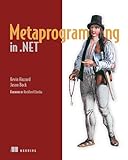AOP in .NET introduces aspect-oriented programming to .NET developers and provides practical guidance on how to get the most benefit from this technique in your everyday coding. The book's many examples concentrate on modularizing non-functional requirements that often sprawl throughout object-oriented projects. Even if you've never tried AOP before, you'll appreciate the straightforward introduction using familiar C#-based examples. AOP tools for .NET have now reached the level of practical maturity Java developers have relied on for many years, and you'll explore the leading options, PostSharp, and Castle DynamicProxy.
About the TechnologyCore concerns that cut across all parts of your application, such as logging or authorization, are difficult to maintain independently. In aspect-oriented programming (AOP) you isolate these cross-cutting concerns into their own classes, disentangling them from business logic. Mature AOP tools like PostSharp and Castle DynamicProxy now offer .NET developers the level of support Java coders have relied on for years.
About this BookAOP in .NET introduces aspect-oriented programming and provides guidance on how to get the most practical benefit from this technique. The book's many examples concentrate on modularizing non-functional requirements that often sprawl throughout object-oriented projects. You'll appreciate its straightforward introduction using familiar C#-based examples.
This book requires no prior experience with AOP. Readers should know C# or another OO language.
What's Inside - Clear and simple introduction to AOP
- Maximum benefit with minimal theory
- PostSharp and Castle DynamicProxy
Purchase of the print book includes a free eBook in PDF, Kindle, and ePub formats from Manning Publications.
Table of Contents PART 1 GETTING STARTED WITH AOP - Introducing AOP
- Acme Car Rental
PART 2 THE FUNDAMENTALS OF AOP - Call this instead: intercepting methods
- Before and after: boundary aspects
- Get this instead: intercepting locations
- Unit testing aspects
PART 3 ADVANCED AOP CONCEPTS - AOP implementation types
- Using AOP as an architectural tool
- Aspect composition: example and execution














